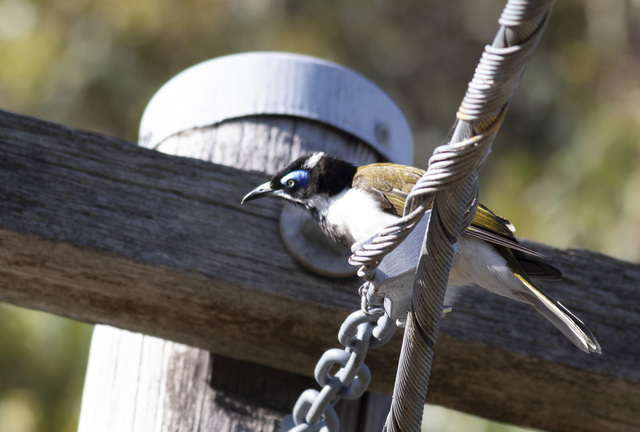In the last edition of the Voice I wrote that I was hoping for some rain and my wishes were granted with a few days of decent wet weather.
I must go to Ocean Grove Nature Reserve and check out the ponds to see if the rain has filled them up, as last time I was there they were nearly dry.
I had a road trip to Bendigo last week. If Winchelsea is the little corella capital of Victoria, then Bendigo has to be the lorikeet capital.
I have never seen so many lorikeets including rainbow, musk, purple-crowned and little lorikeets all buzzing between the many flowering gum trees in the centre of the city.
They were impossible to photograph as they were moving so quickly in the tree canopy.
I saw two blue-faced honeyeaters in Bendigo and subsequently found out that there have been four of these beautiful birds seen recently on the Bellarine near Portarlington. Blue-faced honeyeaters are a large black, white and olive-green honeyeater with bright blue skin around the eye. The crown, face and neck are black with a narrow white band across the back of the neck. The upperparts and wings are a golden olive green, and the underparts are white, with a grey-black throat and upper breast.
The blue-faced honeyeater is found in mainly tropical forest regions of northern and eastern mainland Australia, from the Kimberley region, Western Australia to near Adelaide. It is more common in the north of its range. It is not found in central southern New South Wales or eastern Victoria.
They are sedentary in the northern regions and are nomadic in the south. Seasonal movements have been observed in parts of New South Wales and southern Queensland. It is interesting that this species uses the nests of other species of birds rather than constructing their own nest from scratch.
They take over the abandoned nests of grey-crowned babblers, noisy, silver-crowned and little friarbirds, noisy miner, red wattlebird, Australian magpie, magpie-lark, butcherbirds or the chestnut-crowned babbler. Sometimes the nests are not modified, but often they are rebuilt and relined.
I received an email from Carole, who reported that a group of the Bellarine BirdLife members wandered along the beach at Connewarre and enjoyed watching the various summer visitors who were relaxing after their long migration flight from the far north (Alaska and Russia).
It always amazes Carole how these tiny little things (known as red-necked stints) can fly such distances. The beach was packed with them and many other birds.
Carole also spotted a fledgling grey butcherbird sitting in a tree near the Barwon River at Barwon Heads. This young bird wasn’t alone as parents were about, providing sustenance to the fledgling.
Carole has just returned from Costa Rica where she spent three weeks birding and had an incredible time observing many magnificent birds such as flamingos and blue ibis.
It’s hooded plover breeding season on our beaches, so please observe the dog regulations and heed the signs around the beaches. From December 1, dogs are prohibited on the beach on the spit and Raff’s beach from 9am to 7pm, and must be on the leash at all other times. Between 8W and 13W dogs are permitted off leash at all times of the year if they are under effective control. There are a few nests on our beaches currently.









